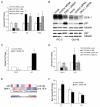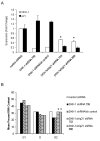p21CIP-1/WAF-1 induction is required to inhibit prostate cancer growth elicited by deficient expression of the Wnt inhibitor Dickkopf-1
- PMID: 21098705
- PMCID: PMC3059079
- DOI: 10.1158/0008-5472.CAN-10-0440
p21CIP-1/WAF-1 induction is required to inhibit prostate cancer growth elicited by deficient expression of the Wnt inhibitor Dickkopf-1
Abstract
Osteoblastic bone metastases are the most common metastases produced by human prostate cancers (PCa). Deregulated activity of Wnt growth factors resulting from overexpression of the Wnt inhibitor Dickkopf-1 (DKK-1) is known to contribute to formation of the osteoblastic component of PCa skeletal bone metastases. In this study, we report that DKK-1 knockdown in osteolytic human PCa cells unexpectedly delays the development of both soft tissue and osseous lesions. PCa cells deficient in DKK-1 expression did not increase canonical Wnt signaling in target osteoblast cell lines; however, DKK-1 knockdown PCa cells exhibited increased expression of the CDK inhibitor p21(CIP1/WAF1) and a 32% increase in G(1) arrest compared with control cells. Ablating p21(CIP1/WAF1) in PCa cells deficient in DKK-1 was sufficient to rescue tumor growth. Collectively, our findings demonstrate that DKK-1 overexpression supports tumor growth in part by restricting expression of p21(CIP1/WAF1) through a mechanism independent of canonical Wnt signaling.
Figures





Similar articles
-
Dickkopf-1 (DKK-1) stimulated prostate cancer growth and metastasis and inhibited bone formation in osteoblastic bone metastases.Prostate. 2011 May;71(6):615-25. doi: 10.1002/pros.21277. Epub 2010 Oct 18. Prostate. 2011. PMID: 20957670 Free PMC article.
-
Effects of Dickkopf-1 (DKK-1) on Prostate Cancer Growth and Bone Metastasis.Cells. 2023 Nov 24;12(23):2695. doi: 10.3390/cells12232695. Cells. 2023. PMID: 38067123 Free PMC article.
-
Prostate cancer cells promote osteoblastic bone metastases through Wnts.Cancer Res. 2005 Sep 1;65(17):7554-60. doi: 10.1158/0008-5472.CAN-05-1317. Cancer Res. 2005. PMID: 16140917
-
Role of Wnts in prostate cancer bone metastases.J Cell Biochem. 2006 Mar 1;97(4):661-72. doi: 10.1002/jcb.20735. J Cell Biochem. 2006. PMID: 16447163 Review.
-
The role of Wnts in bone metastases.Cancer Metastasis Rev. 2006 Dec;25(4):551-8. doi: 10.1007/s10555-006-9022-2. Cancer Metastasis Rev. 2006. PMID: 17160558 Review.
Cited by
-
Dickkopf-1 (DKK1) promotes tumor growth via Akt-phosphorylation and independently of Wnt-axis in Barrett's associated esophageal adenocarcinoma.Am J Cancer Res. 2019 Feb 1;9(2):330-346. eCollection 2019. Am J Cancer Res. 2019. PMID: 30906632 Free PMC article.
-
Systemic Alterations of Wnt Inhibitors in Patients with Prostate Cancer and Bone Metastases.Dis Markers. 2018 Jul 18;2018:1874598. doi: 10.1155/2018/1874598. eCollection 2018. Dis Markers. 2018. PMID: 30116403 Free PMC article.
-
High serum levels of Dickkopf-1 are associated with a poor prognosis in prostate cancer patients.BMC Cancer. 2014 Sep 2;14:649. doi: 10.1186/1471-2407-14-649. BMC Cancer. 2014. PMID: 25182503 Free PMC article.
-
Atlas of Wnt and R-spondin gene expression in the developing male mouse lower urogenital tract.Dev Dyn. 2011 Nov;240(11):2548-60. doi: 10.1002/dvdy.22741. Epub 2011 Sep 20. Dev Dyn. 2011. PMID: 21936019 Free PMC article.
-
Morpholino-driven blockade of Dkk-1 in osteosarcoma inhibits bone damage and tumour expansion by multiple mechanisms.Br J Cancer. 2022 Jul;127(1):43-55. doi: 10.1038/s41416-022-01764-z. Epub 2022 Mar 11. Br J Cancer. 2022. PMID: 35277659 Free PMC article.
References
-
- Keller ET, Zhang J, Cooper CR, et al. Prostate carcinoma skeletal metastases: cross-talk between tumor and bone. Cancer Metastasis Rev. 2001;20:333–49. - PubMed
-
- Bubendorf L, Schopfer A, Wagner U, et al. Metastatic patterns of prostate cancer: an autopsy study of 1,589 patients. Hum Pathol. 2000;31:578–83. - PubMed
-
- Roudier MP, Corey E, True LD, et al. Histological, immunophenotypic and histomorphometric characterization of prostate cancer bone metastases. Cancer Treat Res. 2004;118:311–39. - PubMed
-
- Logothetis CJ, Lin SH. Osteoblasts in prostate cancer metastasis to bone. Nat Rev Cancer. 2005;5:21–8. - PubMed
-
- Hall CL, Bafico A, Dai J, Aaronson SA, Keller ET. Prostate cancer cells promote osteoblastic bone metastases through Wnts. Cancer Res. 2005;65:7554–60. - PubMed
Publication types
MeSH terms
Substances
Grants and funding
LinkOut - more resources
Full Text Sources
Medical

